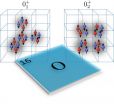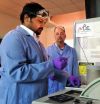(Press-News.org) Oxygen-16, one of the key elements of life on earth, is produced by a series of reactions inside of red giant stars. Now a team of physicists, including one from North Carolina State University, has revealed how the element's nuclear shape changes depending on its state, even though other attributes such as spin and parity don't appear to differ. Their findings may shed light on how oxygen is produced.
Carbon and oxygen are formed when helium burns inside of red giant stars. Carbon-12 forms when three helium-4 nuclei combine in a very specific way (called the triple alpha process), and oxygen-16 is the combination of a carbon-12 and another helium-4 nucleus.
Although physicists knew what oxygen-16 was made of, they were still puzzled by the fact that both the ground and first excited states of the element had zero spin and positive parity. A similar situation occurs in carbon-12 with the ground state and second zero-spin state known as the Hoyle state. At room temperature, only the ground state of oxygen-16 is seen due to the very cold temperature compared to nuclear energies. But the excited states of oxygen-16 become important for the helium-burning reactions inside stars.
"It's expected that oxygen-16 would have zero spin and positive parity as its ground state," says NC State physicist Dean Lee, team member and co-author of a paper describing the research. "What is unexpected is that the first excited state also has these qualities. It made us wonder what the real difference is between the states, which required looking at the structure of the eight protons and eight neutrons in oxygen-16. We had addressed a similar puzzle for the ground state and Hoyle state of carbon-12."
Lee, with colleagues Evgeny Epelbaum, Hermann Krebs, Timo Laehde, and Ulf-G. Meissner, had previously developed a new method for describing all the possible ways that protons and neutrons can bind with one another inside nuclei such as carbon-12 and the Hoyle state. They used an approach called "effective field theory" formulated on a complex numerical lattice that allows the researchers to run simulations that show how particles interact, and so reveal the structure of the nuclei.
In this work, the same team plus Mississippi State physicist Gautam Rupak, found their lattice revealed that although both the ground and first excited states of oxygen-16 "look" the same in terms of spin and parity, they are in fact quite different structurally. In the ground state, the protons and neutrons are arranged in a tetrahedral configuration of four alpha clusters containing two protons and two neutrons each. For the first excited state, the alpha clusters are arranged in a square.
"The production of oxygen-16 from carbon-12 is still very poorly understood from both theoretical and experimental studies," Lee says. "These lattice simulations give us our first look at the structure of low-energy states of oxygen-16."
INFORMATION:
The results appear online March 12 in Physical Review Letters. The work was funded by the U.S. Department of Energy; the National Science Foundation; the Deutsche Forschungsgemeinschaft, Helmholtz-Gemeinschaft Deutscher Forschungszentren and Bundesministerium fuer Bildung und Forschung in Germany; European Union HadronPhysics3 Project and the European Research Council.
peake
Note to editors: Abstract follows
"Ab Initio Calculation of the Spectrum and Structure of 16O"
Authors: Dean Lee, North Carolina State University; Gautam Rupak, Mississippi State University; Evgeny Epelbaum and Hermann Krebs, Institut fuer Theoretische Physik II, Ruhr-Universitaet Bochum, Germany; Timo A. Laehde, Forschungszentrum Juelich, Germany; Ulf-G. Meissner, Helmholtz-Institut fuer Strahlen-und Kernphysik and Bethe Center for Theoretical Physics, Universitaet Bonn, Germany
Published: March 12, 2014 in Physical Review Letters
Abstract:
We present ab initio lattice calculations of the low-energy even-parity states of 16O using chiral nuclear effective field theory. We find good agreement with the empirical energy spectrum, and with the electromagnetic properties and transition rates. For the ground state, we find that the nucleons are arranged in a tetrahedral configuration of alpha clusters. For the first excited spin-0 state, we find that the predominant structure is a square configuration of alpha clusters, with rotational excitations that include the first spin-2 state.
Researchers describe oxygen's different shapes
2014-03-13
ELSE PRESS RELEASES FROM THIS DATE:
Creating a graphene-metal sandwich to improve electronics
2014-03-13
RIVERSIDE, Calif. — Researchers have discovered that creating a graphene-copper-graphene "sandwich" strongly enhances the heat conducting properties of copper, a discovery that could further help in the downscaling of electronics.
The work was led by Alexander A. Balandin, a professor of electrical engineering at the Bourns College of Engineering at the University of California, Riverside and Konstantin S. Novoselov, a professor of physics at the University of Manchester in the United Kingdom. Balandin and Novoselov are corresponding authors for the paper just published ...
UT Arlington research says treadmill workstation benefits employees, employers
2014-03-13
Employees who use treadmill workstations not only receive physical benefits but also are more productive at work, according to a recently published study by researchers from The University of Texas at Arlington, the Mayo Clinic and the University of Minnesota.
Darla Hamann, an assistant professor in the UT Arlington School of Urban and Public Affairs, and four colleagues wrote "Treadmill Workstations: The Effects of Walking while Working on Physical Activity and Work Performance", which was published by the journal PLoS One Feb. 20.
In the study, sedentary employees from ...
Heart scans only useful in prescribing statins under certain conditions, UCSF team reports
2014-03-13
As long as inexpensive statins, which lower cholesterol, are readily available and patients don't mind taking them, it doesn't make sense to do a heart scan to measure how much plaque has built up in a patient's coronary arteries before prescribing the pills, according to a new study by researchers at UC San Francisco.
The researchers created a statistical model to predict whether or not it made sense to do the scan, using data from the Multi-Ethnic Study of Atherosclerosis and other sources. They modeled the effects of statin treatment in 10,000 55-year-old women with ...
Researchers destroy cancer with cryoablation & nanoparticle-encapsulated anticancer drug
2014-03-13
Combining nanodrug-based chemotherapy and cryoablation provides an effective strategy to eliminate cancer stem-like cells (CSCs) the root of cancer resistance and metastasis, which will help to improve the safety and efficacy of treating malignancies that are refractory to conventional therapies.
Cryoablation (also called cryosurgery or cryotherapy) is an energy-based, minimally invasive surgical technique that has been investigated to treat a variety of diseases including cancer, which is done by freezing the diseased tissue to subzero temperature to induce irreversible ...
Same-day double knee replacement safe for select rheumatoid arthritis patients
2014-03-13
Same-day bilateral knee replacement surgery is safe for select patients with rheumatoid arthritis, researchers from Hospital for Special Surgery in New York have found.
Generally, patients with an inflammatory systemic disease such as rheumatoid arthritis (RA) are sicker than patients with the degenerative condition osteoarthritis (OA), says senior study author Mark Figgie, M.D., chief of the Surgical Arthritis Service at Hospital for Special Surgery, and the hospital's first Allan E. Inglis, MD, Chair in Surgical Arthritis.
RA patients are more likely to have conditions ...
Heat-based technique offers new way to measure microscopic particles
2014-03-13
Researchers have developed a new heat-based technique for counting and measuring the size of microscopic particles. The technique is less expensive than light-based techniques and can be used on a wider array of materials than electricity-based techniques. The research was performed by faculty at North Carolina State University, the University of North Carolina at Chapel Hill and Marquette University.
"We launched this study purely out of curiosity, but it's developed into a technique that has significant advantages over existing methods for counting and measuring the ...
A brake for spinning molecules
2014-03-13
This news release is available in German. Chemical reactions taking place in outer space can now be more easily studied on Earth. An international team of researchers from the University of Aarhus in Denmark and the Max Planck Institute for Nuclear Physics in Heidelberg, discovered an efficient and versatile way of braking the rotation of molecular ions. The spinning speed of these ions is related to a rotational temperature. Using an extremely tenuous, cooled gas, the researchers have lowered this temperature to about -265 °C. From this record-low value, the researchers ...
Soft robotic fish moves like the real thing
2014-03-13
Soft robots — which don't just have soft exteriors but are also powered by fluid flowing through flexible channels — have become a sufficiently popular research topic that they now have their own journal, Soft Robotics. In the first issue of that journal, out this month, MIT researchers report the first self-contained autonomous soft robot capable of rapid body motion: a "fish" that can execute an escape maneuver, convulsing its body to change direction in just a fraction of a second, or almost as quickly as a real fish can.
"We're excited about soft robots for a variety ...
Heritable variation discovered in trout behavior
2014-03-13
Populations of endangered salmonids are supported by releasing large quantities of hatchery-reared fish, but the fisheries' catches have continued to decrease. Earlier research has shown that certain behavioural traits explain individual differences in how fish survive in the wild. A new Finnish study conducted on brown trout now shows that there are predictable individual differences in behavioural traits, like activity, tendency to explore new surroundings and stress tolerance. Furthermore, certain individual differences were observed to contain heritable components. ...
3D X-ray film: Rapid movements in real time
2014-03-13
This news release is available in German. How does the hip joint of a crawling weevil move? A technique to record 3D X-ray films showing the internal movement dynamics in a spatially precise manner and, at the same time, in the temporal dimension has now been developed by researchers at ANKA, KIT's Synchrotron Radiation Source. The scientists applied this technique to a living weevil. From up to 100,000 two-dimensional radiographs per second, they generated complete 3D film sequences in real time or slow motion. The results are now published in the Proceedings of the ...





